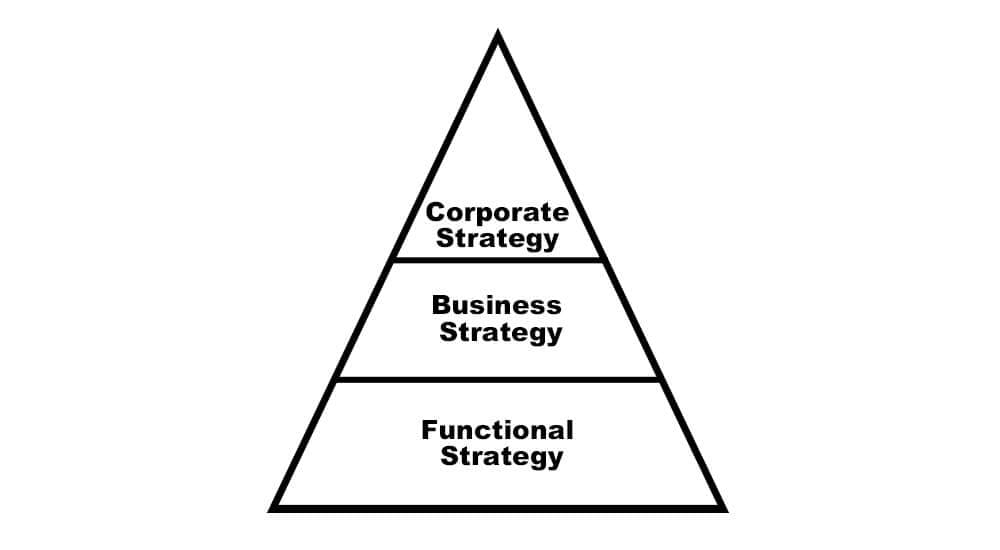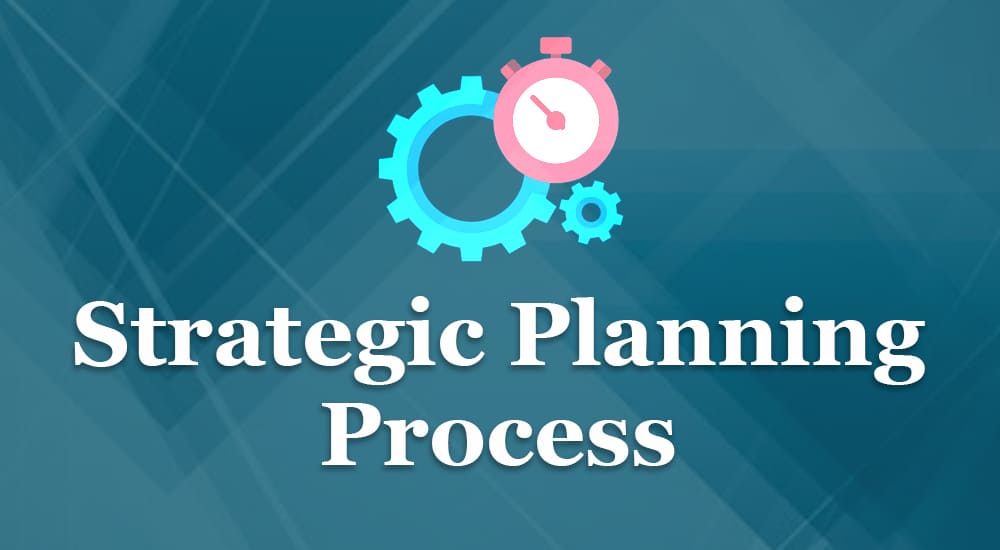The strategic planning process involves creating precise business strategies, acting on them, and assessing the outcomes concerning an organization’s long-term objectives.
Strategic planning rose to prominence in the 1960s when there was a resurgence of interest in strategic business planning, which is still useful.
Importance of the Strategic Planning Process
This process helps a business get insight into three important aspects.
- Business Goals: Business goals should be challenging, realistic, and measurable. They provide reasons for business establishment and what it should do to accomplish its mission. Business goals provide details on who needs to do what and when.
- Business Vision: This is a set of ideas based on the envisioned future of the business. Business visions are flexible and help establish a brand’s culture and product. It is the future of the company.
- Business Mission: This is a set of principles on which the business is established. It is the core idea the business upholds and focuses on.
The strategic planning process helps team members to share the same ideas and stay focused on the company’s vision, mission, and objectives. It helps optimize resource utilization and prevent irrelevant activities.
Strategic planning provides a better insight into market trends and scenarios that may affect the business in the future. It aids in determining and evaluating the most efficient and effective means of achieving the business’s objectives. It can further provide an implementation strategy to keep management and teams on track and accountable for deliveries.
Level of Strategies

A strategy is only feasible when it aligns with the organization’s aim. These strategies originate from the organization’s mission, vision, and goals.
Organizations make every decision based on a strategy. If the strategy is poorly selected and formulated, it impacts employees’ effectiveness.
There are three levels of strategies:
- Corporate-level strategy
- Business-level strategy
- Functional-level strategy
Corporate-Level Strategy
Organizations decide what business they should operate at the corporate level and get a competitive edge. It is about picking optimal businesses and determining how they should be integrated into a corporate level.
Business-Level Strategy
It is essential to understand the business and external environment and answer questions such as “How do we compete?” and “How do we achieve a competitive edge over rivals?” Organizations can implement frameworks like Value Chain Analysis, VRIO Model, Porter’s Five Forces, and PESTLE Analysis.
The business-level strategy aims to gain a competitive advantage by delivering actual value to customers.
Functional-Level Strategy
The functional-level strategy involves: “How do we support the business-level strategy within functional departments, such as Marketing, HR, Production, and R&D?” These strategies help improve the effectiveness of departments within an organization.
Strategy Implementation in Samsung
Samsung is a conglomerate with multiple strategic business units (SBUs). Samsung deals with smartphones, cameras, TVs, microwaves, refrigerators, laundry machines, chemicals, and insurance.
Each product or strategic business unit requires a business strategy to compete in the niche. At the corporate level, Samsung has to choose more fundamental questions like: “Should we pursue the camera business, grow the smartphone business, or should we focus on the television business?”
The BCG Matrix or the GE McKinsey Matrix are the portfolio analysis tools utilized to figure this out.
The choices are key to the future course of action. They help organizations decide what to do and what not to do.
Steps in Creating a Strategic Plan
The steps to create a strategic plan are as follows:
Step 1: Collect Information, Opinions, and Results for Consideration.
Past strategic plans, staff, and environmental surveys provide useful information.
PESTLE analysis is important as it considers external factors that affect the business.
Output from SWOT analysis should be reviewed. This analysis focuses on internal processes and situations and other external factors that might affect the business.
Examining the above information helps develop a business’s strategic plan. When this information is accurate, it helps business owners and stakeholders make informed decisions.
Step 2: Have a Clear Vision for the Business
This is an important step towards creating a successful strategic plan.
It answers questions like:
- Where is the business headed?
- What does success look like?
A vision statement is different from the business’s future. A vision helps the business develop a strategic plan. A vision is like a blueprint of a house, and a strategic plan is a house. The foundation of the business’s strategic plan is the business’s vision.
For any type of organization, understanding what the organization is building and how it is helpful to users will give insight into the organization’s vision.
All team members must share the same ideology; otherwise, there won’t be synergy, and each employee will have different success criteria.
Step 3: Have a Mission for the Business
The owners must understand the business’s purpose, what needs to be done, and the target audience. This ensures that the business achieves what it sets out to achieve. This will help business owners be more efficient and channel energy and resources into the right places.
Step 4: Set and Share Values
When values are shared within an organization, it creates a uniform pattern of behaviors among team members.
These values are like rules that everyone has to follow. These values are shared by top leadership, and team members follow them.
When employees observe the values held by the leadership, it motivates them to contribute to the business’s success.
Step 5: Handling Competition, Weaknesses, Risks, and Other Issues
A business always has some impediments that affect its operations. However, success is not based on the competition, weaknesses, risks, or setbacks encountered but rather on managing them.
Every business faces these challenges, and while some don’t survive, others succeed. So handling competition, weaknesses, risks, or setbacks plays a vital role in the success of a business and should be incorporated in the business’s strategic planning.
The chances of a business being affected by these problems are significantly reduced when these scenarios have already been identified and factored in during the planning process.
Businesses can incorporate risk management to manage risks.
Step 6: Set Business Strategies, Goals, Tactics, and Priorities
This step involves setting strategic priorities. When these priorities are set, it helps the organization focus on the right things. Businesses that incorporate this into their strategic planning increase their overall chance for success.
After setting strategic priorities, businesses find realistic ways to measure success. This helps with accountability when it comes to strategic planning.
Measuring these priorities helps evaluate the business’s current state, future state, and time spent moving from its current state to the desired future state.
Besides setting the goals and priorities, it is more important to curate a set of actions that will accomplish the goal.
Step 7: Organize a Communication Plan
A sound communication plan is a must for the optimal functioning of the organization. Several methods could be used in achieving this, such as audio and video meetings, live meetings, sessions, etc.
It is important to communicate the progress and effective strategies with team members to ensure they buy into the plan, stay informed and updated on where the organization is going and offer potential solutions and contributions to making the overall business success.
It is important to allow two-way communication so the ideas from team members can be taken into account. Furthermore, teamwork is fostered within the organization when team members are allowed to make input because they will feel connected with the organization’s vision. This has far better results than imposing plans on team members.
Step 8: Implementation and Action
Most organizations fail, therefore a robust plan of action is necessary. “Easier said than done” is a famous statement relevant to the corporate world. This means it is far easier to develop a strategic plan than to implement it. But unfortunately, there is a 71% failure rate of organizations implementing their plans. Why is this so?
This is because setting goals is easy but implementing actions to achieve goals is tough. To achieve a goal, accountability is a must.
Systems are broken down into actionable goal-oriented steps, and accountability ensures that these steps are taken. If the system is set and followed, achieving the goal is easy.
Conclusion
A growing number of businesses are using strategic planning to help them design and implement sound decisions. While planning takes a considerable amount of money, time, and effort, a well-thought-out strategic plan may help an organization develop, fulfill its goals, and keep employees happy.
The complex nature of the human and internal organizational environment makes the task difficult. However, great managers and leaders can combine successful long-term strategy with implementation.

Great process and very easy to understand.